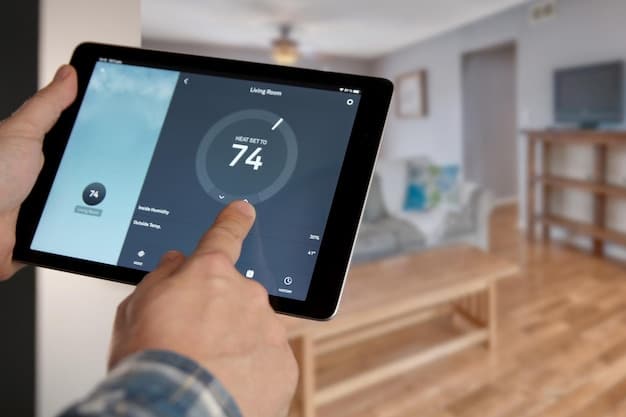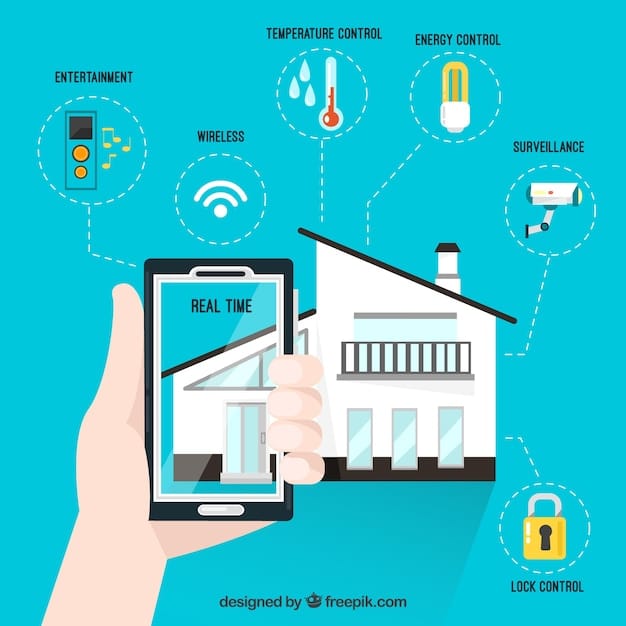Smart Thermostat Showdown: Top Energy-Saving Models for 2025

The Smart Thermostat Showdown for 2025 focuses on identifying the models that offer the most significant energy savings through advanced features like adaptive learning, geofencing, and integration with renewable energy sources, ultimately reducing energy consumption and lowering utility bills.
Are you ready to take control of your home’s energy consumption and save money while doing it? The Smart Thermostat Showdown: Which Model Saves You the Most Energy in 2025? is here to guide you through the latest innovations in smart thermostat technology, helping you make an informed decision that benefits both your wallet and the environment.
Understanding Smart Thermostats and Energy Efficiency
Smart thermostats have revolutionized home energy management, offering a level of control and automation that traditional thermostats simply can’t match. But how exactly do these devices contribute to energy efficiency, and what features should you look for when choosing one?
Benefits of Smart Thermostats
Smart thermostats offer a myriad of benefits that extend beyond simple temperature control. They learn your habits, adjust to weather patterns, and integrate with other smart home devices to optimize energy usage.
Key Features to Look For
When selecting a smart thermostat, consider features like geofencing, which adjusts the temperature based on your location; learning capabilities, which allow the thermostat to adapt to your schedule; and compatibility with other smart home systems.
- Adaptive Learning: Thermostats that learn your heating and cooling patterns.
- Geofencing: Adjusts temperature based on your smartphone’s location.
- Remote Control: Allows you to adjust settings from anywhere via a mobile app.
Ultimately, understanding these aspects allows you to select the best smart thermostat. Next, we’ll explore the key factors to consider before making a purchase.
Factors to Consider Before Buying a Smart Thermostat
Choosing the right smart thermostat involves more than just picking the sleekest design. Several key factors can influence your decision, from compatibility with your existing HVAC system to your budget and desired level of automation.
HVAC System Compatibility
Ensure the smart thermostat you choose is compatible with your home’s heating, ventilation, and air conditioning (HVAC) system. Most thermostats work with standard systems, but older or more complex setups may require specific models or adapters.
Budget and Long-Term Savings
While smart thermostats can lead to significant energy savings, the initial investment can vary widely. Consider your budget and calculate the potential long-term savings to determine the most cost-effective option.

Carefully evaluating these aspects will help you choose a smart thermostat that meets your specific needs. Later in the article, we’ll dive into some of the top models expected to deliver significant energy savings in 2025.
Top Smart Thermostat Models for Energy Savings in 2025
As technology advances, smart thermostats continue to evolve, offering even greater energy savings and more sophisticated features. Here are some of the top models expected to lead the way in energy efficiency in 2025:
Ecobee Smart Thermostat Premium
The Ecobee Smart Thermostat Premium is known for its advanced sensors and integration with other smart home devices like Apple HomeKit and Alexa, the Ecobee offers precise temperature control and energy management. It learns your routines and adjusts the temperature accordingly, saving you energy and money.
Google Nest Learning Thermostat
The Google Nest Learning Thermostat stands out for its user-friendly interface and advanced learning capabilities. It adapts to your schedule and preferences over time, automatically adjusting the temperature to optimize energy savings. The Nest also offers features like geofencing.
- Honeywell Home T9 Smart Thermostat: Zoned temperature control for total home usage optimization.
- Sensibo Sky Smart AC Controller: Retrofitting option if you only utilize split ACs.
- Wyze Thermostat : Easy to use and easy to schedule with intuitive control schemes.
Exploring the key models is crucial. Next, we’ll consider the impact of smart home integration on energy efficiency.
The Role of Smart Home Integration
Smart thermostats don’t operate in isolation; they are part of a larger ecosystem of smart home devices that can work together to optimize energy consumption. Integrating your smart thermostat with other devices can unlock even greater energy savings.
Connecting with Smart Lighting
Linking your smart thermostat with smart lighting systems can create a comprehensive energy-saving strategy. For example, when you leave the house and your thermostat sets back the temperature, your smart lights can automatically turn off.
Integrating with Smart Shades
Smart shades can work in tandem with your smart thermostat to regulate temperature based on sunlight. In the summer, shades can lower automatically to block out heat. Also, consider using weather-aware scheduling. These settings will raise and lower automatically based on outside temps and save you money.

These options can help you minimize energy usage while increasing home security. Finally, we will consider government incentives and rebates.
Government Incentives and Rebates for Smart Thermostats
To encourage energy efficiency, many governments and utility companies offer incentives and rebates for installing smart thermostats. Take advantage of these programs to lower the upfront cost and accelerate your return on investment.
Federal Tax Credits
The federal government provides tax credits for energy-efficient home improvements, including the installation of qualified smart thermostats. Check the latest guidelines to see if your chosen model is eligible and save even more.
Local Utility Rebates
Many local utility companies offer rebates for smart thermostat purchases. These rebates can significantly reduce the initial cost and make energy-efficient upgrades more affordable. Check with your utility provider for available programs.
- State and Local Programs: Check for localized incentives in your area.
- Energy Efficiency Organizations: Programs offered by advocacy groups can help your bottom line.
- Manufacturer Promotions: Sales and time-limited promotions can reduce costs as well.
Ultimately, by combining smart thermostats with other components, you can maximize your efficiency. We will explore how to prepare for peak savings next.
Preparing for Peak Energy Savings
Installing a smart thermostat is just the first step; maximizing your energy savings requires ongoing monitoring and adjustments. By actively managing your thermostat settings and tracking your energy usage, you can achieve peak efficiency.
Setting Optimal Schedules
Take the time to create detailed schedules that align with your daily routines. Adjust the temperature for when you’re away from home, asleep, or actively using different rooms. Fine-tune your settings to achieve greater savings.
Monitoring Energy Usage
Regularly monitor your energy usage through your smart thermostat’s app or online portal. Use this data to identify patterns and make adjustments to your settings. Tracking your usage is essential for achieving peak savings.
| Key Aspect | Brief Description |
|---|---|
| 💡 Model Selection | Choose models like Ecobee & Nest for smart features. |
| 💰 Rebates & Credits | Utilize government incentives to lower costs. |
| 🏡 Smart Home Integration | Connect with lighting & shades for peak efficiency. |
| 📅 Optimal Schedules | Fine-tune settings based on your routines. |
Frequently Asked Questions
▼
Smart thermostats can potentially save you up to 10-15% on your heating bill and 15% on your cooling bill. The actual savings varies widely depending on usage habits and regional climate conditions.
▼
Most smart thermostats come with step-by-step installation guides. However, if you’re uncomfortable working with electrical wiring, hiring a professional installer is advisable. It could save you tons of money in the long run!
▼
Smart thermostats are generally compatible with most HVAC systems. Ensure it supports your setup’s voltage and wiring. Some old homes may also need a C-wire adapter for full functionality.
▼
Most of them do usually offer the basic functionality without one. Additional features like detailed energy reports, expanded cloud storage for recorded video, and professional monitoring services require a subscription.
▼
It depends on the usage, but regular seasonal adjustments are also beneficial. Monitor usage for two to three months minimum. Adjusting regularly provides the benefit of optimized energy savings.
Conclusion
As we look ahead to 2025, the smart thermostat market promises even more innovative options for energy-conscious homeowners. By considering factors like HVAC compatibility, smart home integration, and government incentives, you can make an informed decision and choose a model that not only saves you money but also contributes to a more sustainable future.





